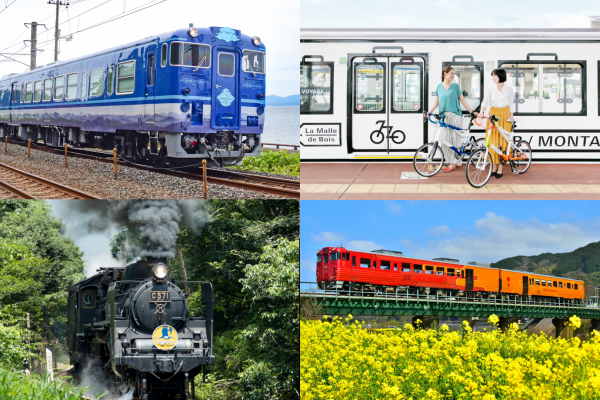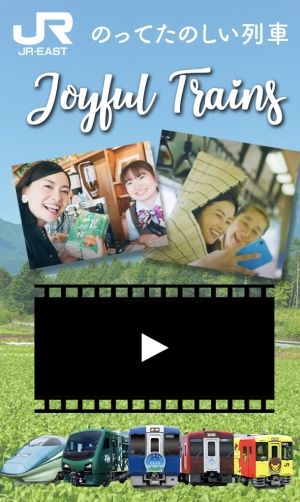West Japan: 4 Fantastic trains and where to find them

When we think about visiting Japan, most of us immediately picture big cities like Tokyo (東京), Osaka (大阪), and Kyoto (京都), made accessible conveniently to us by high-speed Shinkansen (新幹線) trains. While they are certainly fun, exciting places to visit, Japan also has much to offer in the way of slower, more scenic travel experiences by rail—and what better way to introduce them than on Railway Day (14 October) itself! These trips are made possible in part due to JR West’s and JR Shikoku's lineup of sightseeing trains, which are themed according to the sights, sounds, tastes, and activities unique to their respective regions.
1. Ametuchi (あめつち)
The Ametuchi train, faithfully chugging its way down the Japanese countryside on a bright, cloudless day. (Image credit: West Japan Railway Company)
Area: Tottori (鳥取), Shimane (島根)
Route: Tottori Station (鳥取駅) ↔︎ Izumoshi Station (出雲市駅)
Duration: About 3.5–4 hours each way
Frequency: 1 round trip per day
The Ametuchi sightseeing train (あめつち列車 Ametsuchi ressha) is a striking shade of blue, and promises to bring you through the San’in (山陰) area, a region of Japan said to be home to the roots of traditional Japanese culture. Passengers on this train can expect to find locations that bridge the best of Japan’s traditional history and culture with the modern convenience of rail travel! From Tottori’s famous sand dunes to Shimane’s Izumo Grand Shrine (出雲大社 Izumo taisha), often spoken of as Japan’s Home of the Gods, this train is a must-try for travellers who want to experience the best of the San’in region.
The red and green decorative elements in this car are actually different types of locally-woven textiles from Tottori and Shimane prefectures, and impart subtle but highly classy feel to the interior of this train. (Image credit: West Japan Railway Company)

Make sure to check out their lineup of train bento boxes, which run the gamut from savoury lunches to light dessert courses. This particular box is available on the Izumoshi-Tottori route, and features handmade wagashi (和菓子, traditional Japanese sweets) inspired by the Japanese creation myth of Izanagi (イザナギ) and Izanami (イザナミ). (Image credit: West Japan Railway Company)
Reserved seats are required for this train and cost ¥1,900 per person. Trains run on weekends, with additional services occasionally being offered on Mondays.
Head down to their English website for more information about the train’s timetable and exclusive San’in produce-themed bento boxes, and to their Japanese page for more details on the architectural aspects of its interior.
2. La Malle de Bois (ラ・マル・ド・ボア)

Very stylish exterior of the train. (Image credit: West Japan Railway Company)
Area: Setouchi (瀬戸内)
Route: Okayama Station (岡山駅) ↔︎ Uno Station (宇野駅) / Onomichi Station (尾道駅) / Kotohira Station (琴平駅) / Hinase Station (日生駅)
Frequency: 1 round trip per day
The La Malle de Bois (ラ・マル・ド・ボア Ra Maru do Boa), French for “wooden suitcase”, is the perfect train for the art-lovers amongst us! This train, which was designed around the concept of merging bicycle tourism with rail travel, is finished with a stylish white-and-black design on its exterior. It also comes with storage space for up to 8 regular bicycles per carriage, making it the perfect train for travellers who are looking to explore the art islands in the Setouchi area. These islands—Naoshima (直島), Teshima (豊島), and the like—which are perhaps most famously known for being home to installations like artist Kusama Yayoi’s (草間彌生) giant polka-dotted pumpkin, are renowned cycling destinations as well.
While on your journey, kick back and soak in the artistic atmosphere of the train’s interior, which is decorated with contemporary art pieces by Japanese artists.

Built-in bicycle storage spaces on board. (Image credit: West Japan Railway Company)

The interior of this train features a row of bar stools along one side of the train, giving you prime access to views of the Japanese countryside as you travel out to the art islands. Why not grab a snack and take some time to slow down and soak in the atmosphere? (Image credit: West Japan Railway Company)
Reserved seats are required for this train and cost per person varies depending on which stop you get off at; this train service is unique in that it has three different destinations, and thus uses three different routes. Free Wi-fi is available within the train itself. Bicycle storage spaces, while free for passengers, must be reserved in advance. For more information on ticket prices and other offerings on this train, be sure to check out their official Japanese website.
3. SL Yamaguchi (SL「やまぐち」)
If you squint, you might mistake it for the Hogwarts Express. (Image credit: West Japan Railway Company)
Area: Yamaguchi (山口), Shimane (島根)
Route: Shin-Yamaguchi Station (新山口駅) ↔︎ Tsuwano Station (津和野駅)
Duration: About 2 hours each way
Frequency: One round trip per day
The SL (steam locomotive) Yamaguchi (SL「やまぐち」) is a retro-styled train that may as well have stepped right out of a children’s storybook. With its robust engine, which pushes billowing clouds of steam from the top of the train as it travels down Yamaguchi Line (山口線), to its iconic whistle, this train is a great way to take in the sights of the western-most end of Honshu (本州). This train also includes small exhibits and hands-on experiences for passengers who want to know more about the train they’re riding on.
Getting tired of sitting around all the time? Stretch your legs and have a peek at the various exhibits about the history of the train! (Image credit: West Japan Railway Company)

Strolling along “Little Kyoto”, Tsuwano. (Image credit: Shimane Prefecture)
Passengers making their way to Tsuwano (津和野) from Shin-Yamaguchi (新山口) will pass through three general areas: Yamaguchi, Ato (阿東), and Tsuwano. These regions are rich in natural scenery and sightseeing locations, such as hot springs, vast canyons, and historic castle towns. At the train’s final stop, Tsuwano—known affectionately as the “Little Kyoto” of the Sanyo (山陽) region—provides travellers with a chance to stretch their legs at local shrines and historical villas.
The SL Yamaguchi operates for a limited time period during the year, and in 2021 will be running on weekends from 23 October–19 December. Reserved seats are required for this train and range from ¥770 to ¥2,170 depending on where you get on and off. For more information about their route, timetable, seat availability, and prices, check out their official website here.
4. Iyonada Monogatari (伊予灘ものがたり)

From Japanese castles to the coast, get your fill of the mountains and the seas on this route. (Image credit: Ehime Prefecture)
Area: Ehime (愛媛)
Route: Matsuyama Station (松山駅) ↔︎ Iyo-Ozu Station (伊予大洲駅) / Yawatahama Station (八幡浜駅)
Duration: About 2 hours each way
Frequency: 2 round trips a day
The Iyonada Monogatari (伊予灘ものがたり) is a two-car sightseeing train that runs along the Iyonada Sea (伊予灘) while also giving its passengers an indulgent view along the Hijikawa River (肱川). Designed with a nostalgic, retro-modern aesthetic, this train promises both a feast for your eyes and belly alike! Its cars are painted a warm red and gold, meant to evoke images of the rich sunsets visible from Iyonada, as well as juicy citrus fruits—one of the many types of produce that Ehime is known for growing. Passengers can round out their Ehime experience by savouring their train meal sets, which are made lovingly with local produce. As you may have noticed, this train seems to be designed around a slow, romantic sort of atmosphere; it is no wonder then that it runs on the “Iyonada Line of Love” (愛ある伊予灘線 Ai aru iyonada sen)!

Lean back and bask in the golden glow of the afternoon sun and an unfettered view of the ocean. (Image credit: West Japan Railway Company)
Do note that unlike the other trains mentioned here, the Iyonada Monogatari is operated by JR Shikoku and its tickets cannot be combined with a rail pass. Round-trip tickets for this train are instead booked in advance as their own package alongside a meal set of your choice: passengers setting off from Matsuyama Station in the morning can enjoy a breakfast and lunch set, while passengers taking the afternoon train can select a lunch and afternoon tea meal. Reservations must be made within 10-30 days prior to your trip. For more information on train offerings and prices, check out their English website.
This rail experience is made complete with the warm enthusiasm of the service team, who embody the best of Japanese hospitality! (Image credit: West Japan Railway Company)
Japan is home to a vast range of experiences beyond what we usually see on popular tourism websites, and these trains are the perfect way to try something new! Even though travelling abroad still seems like a far-flung dream under our current circumstances, why not shop around the JR West and JR Shikoku websites in the meantime to prepare for when your next overseas trip to Japan becomes possible?
Alternatively, take a virtual trip and gather sightseeing and rail travel tips at The Japan Rail Fair—definitely a fun way to celebrate Railway Day before visiting Japan!
Header image credit: West Japan Railway Company




